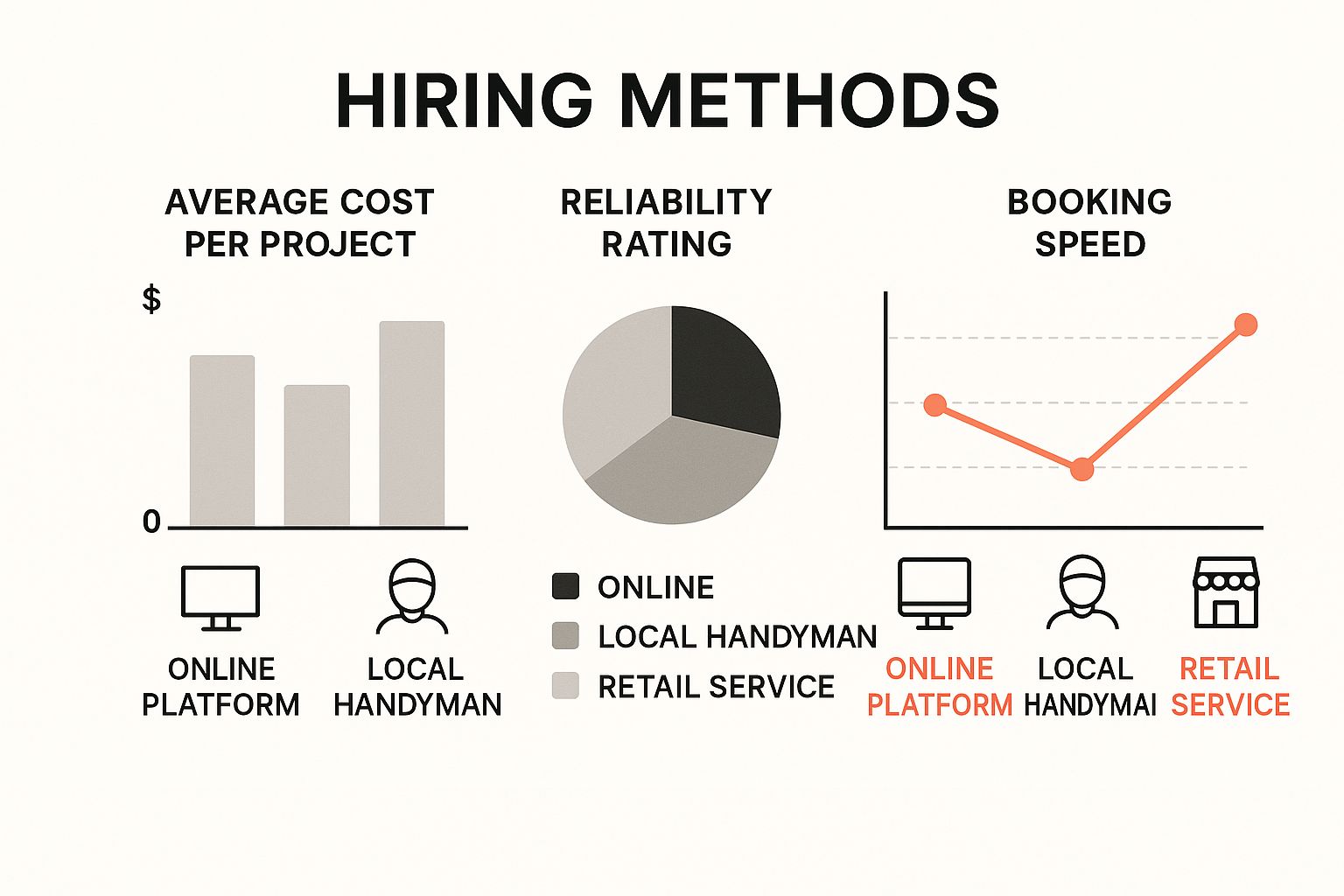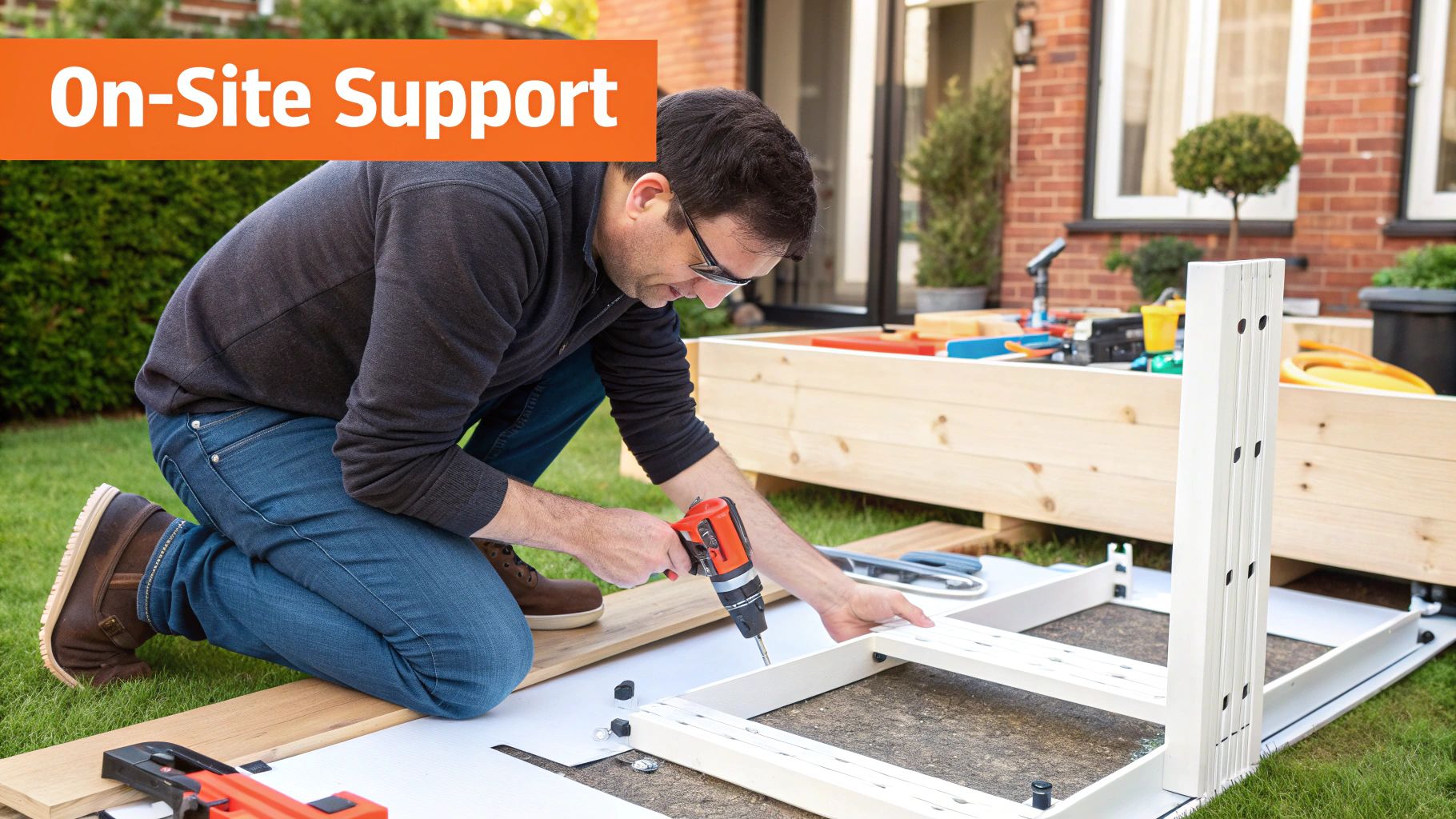-
CALL US:
- (866) 952-3456
That brand-new flat-pack box from IKEA or Wayfair looks simple enough, right? But then you open it and face a mountain of screws, a hundred little pieces, and diagrams that might as well be in another language. Deciding to hire someone to assemble furniture is a smart move that lets you skip the headache and ensures your new purchase is built correctly and safely from the very beginning.

More and more people are choosing to outsource furniture assembly, and for good reason. It’s not just about getting your Saturday afternoon back; it's an investment in quality, safety, and your own peace of mind. It’s easy to underestimate the time and potential for disaster lurking in what looks like a simple project.
A professional assembler shows up with more than just a toolbox. They bring experience. They know how to decipher those confusing, illustration-only instructions and have the right tools to make every connection secure without damaging delicate materials like particleboard.
They’ve seen it all, so they know how to prevent the common mistakes that lead to wobbly tables or crooked drawers. You can get more specific insights on this in our guide about https://assemblysmart.com/why-you-should-hire-a-professional-to-build-ikea-furniture-for-you/.
A professional's expertise is your best defense against stripped screws, cracked panels, and the dreaded realization that a key piece was installed backward three steps ago. This ensures the final product is not only beautiful but also structurally sound.
Let's be honest, your time is precious. A task that might take you four to six frustrating hours is often something a pro can knock out in a fraction of that time.
This efficiency is exactly why the furniture assembly market is booming. It's projected to hit about $374.5 million in 2025, driven by people who see the value in convenient, time-saving solutions.
This same logic applies to other complex tasks. Just like you'd hire an expert for furniture, understanding the benefits of hiring a professional realtor highlights how specialized knowledge saves time and prevents expensive mistakes in other parts of life. Hiring a pro is simply an investment in getting the job done right the first time.
Alright, so you've decided to save yourself the headache and hire someone to put that new furniture together. Smart move. But finding the right person for the job is where the real work begins. This is about more than just a quick online search; you need to know where to look and what to look for.
Your first stop should probably be one of the dedicated gig-economy platforms like TaskRabbit or Thumbtack. These sites are literally built to connect you with skilled folks who do this all day long. They offer a huge pool of "Taskers" or pros, and you can see their hourly rates, specific experience, and—most importantly—what recent customers have to say about them.
But don't stop there. Local handyman websites can be a goldmine for experienced, independent assemblers. Community forums or even neighborhood social media groups are also great for getting genuine recommendations from people who have hired someone recently. Lastly, some furniture retailers offer assembly as an add-on service. It can sometimes be a bit pricier, but it’s often a very reliable, no-fuss option.

As you can see, there’s a trade-off. Online platforms often get you someone the fastest, while a local handyman might hit that sweet spot between cost and proven reliability.
To make it even clearer, let's break down where you might look to find your perfect assembly pro.
Choosing the right platform is the first step in finding a reliable pro. Each has its own set of benefits and drawbacks depending on what you prioritize—speed, cost, or a personal recommendation.
| Platform / Method | Best For | Key Considerations |
|---|---|---|
| Gig Apps (TaskRabbit, Thumbtack) | Speed, convenience, and a wide selection of assemblers. | Rates can vary widely. Vetting is crucial—rely on recent reviews and photos. |
| Local Handyman Services | Finding established, often more experienced professionals. | May require more research (calling, checking websites). Booking might not be instant. |
| Retailer Assembly Service | Convenience and reliability, especially for their own products. | Often the most expensive option. Limited to the retailer's approved contractors. |
| Community Referrals (Nextdoor, Facebook) | Getting trusted, word-of-mouth recommendations. | Availability can be hit-or-miss. You'll need to vet insurance and experience yourself. |
Ultimately, the best method depends on your specific needs. For a quick, common job, an app is fantastic. For a complex or expensive piece, a vetted local pro might be worth the extra effort.
Once you have a shortlist of a few potential assemblers, it’s time to dig in. This isn't just about finding the cheapest hourly rate; it's about finding the most dependable person who won't turn your new dresser into a pile of expensive firewood. A nice profile is a good start, but you need to go a bit deeper.
Pay close attention to these things:
A true professional will be totally upfront about their experience, insurance, and policies. If a candidate gets cagey when you ask about insurance, can't show you any past work, or pressures you to book immediately, take it as a massive red flag and move on.
Putting in a little extra time on the front end to properly vet your candidates is what separates a smooth, successful assembly from a total disaster. It turns what could be a gamble into a predictable, stress-free experience.

Nobody likes a financial surprise, especially after you've already stretched your budget for that new piece of furniture. When you decide to hire someone to put it all together, getting a solid, upfront quote is the key to a stress-free experience.
Most professional assemblers price their work in one of two ways. Understanding the difference helps you get the best value for your specific job.
The first model is a flat fee per item. This is perfect when you have a single, more complex piece, like that huge wardrobe from IKEA or a multi-part entertainment center. You know the exact cost before they even start, no matter how many hours it takes. The other common method is an hourly rate, which often makes more sense if you have several smaller, simpler items to build—think a set of dining chairs plus a couple of nightstands.
This kind of service flexibility is a huge reason the furniture assembly market is booming. It was valued at USD 5.5 billion globally and is only expected to keep growing as more people discover the convenience of ready-to-assemble furniture.
If you want a truly accurate quote, you have to give the assembler the right details from the get-go. Vague requests will only get you vague—and often underestimated—quotes. A little prep work on your end makes a world of difference.
Before you even send that first message, pull together this information:
Pro Tip: Use This Message Template
"Hi, I'm looking for a quote to assemble the following furniture:
- Item 1: [Furniture Name, e.g., IKEA MALM 6-Drawer Dresser]
- Product Link: [Paste the URL to the product page]
- My Location: [Your general area or zip code]
- Any special considerations? [e.g., located on the 3rd floor with no elevator]
Could you please provide a flat-fee or estimated hourly quote? Thanks!"
Providing this level of detail allows a pro to accurately gauge the project's complexity and give you a quote you can actually count on. For a deeper look into all the things that can influence the final price, check out our complete breakdown of furniture assembly service costs.
An assembly day that goes off without a hitch isn't about luck—it's about smart preparation. When you hire a professional to build your new furniture, a few simple steps beforehand can make a world of difference. It speeds up the job, which can save you time and money.
First things first: get the box into the right room. It sounds obvious, but you'd be surprised how many delivery services only offer curbside drop-off. Your assembler's clock starts the second they walk through your door, so you definitely don't want to pay their hourly rate for them to haul a 150-pound wardrobe box up two flights of stairs. Moving it yourself means they can get straight to work.
Once the box is in place, you need to clear a proper workspace. I've seen it all, and the best outcomes happen when there's plenty of room. A good rule of thumb is to clear an area at least twice the size of the finished piece of furniture. This gives the assembler enough space to lay out all the components and move around without bumping into your other stuff or scuffing up your walls.
It’s also a really good idea to do a quick parts check before they show up. You don't have to count every last nut and bolt, but at least open the box and make sure the main panels and hardware bags are actually in there. Finding out a critical piece is missing after the pro has already started can turn a simple two-hour job into a frustrating two-visit headache.
Remember, the goal is to eliminate any friction. Simple things like making sure there’s a clear parking spot or letting your pro know about building rules (like service elevator hours) helps them work without interruption.
Following these tips helps create a totally seamless experience. For a more exhaustive checklist, you can check out our complete guide on how to prepare for your furniture assembly project. Trust me, a little bit of planning goes a very long way.

Alright, the moment of truth has arrived. Your professional assembler is at the door, and the project is about to kick off. Your role now shifts from planner to a sort of hands-off supervisor. How you handle these final stages is key to getting the quality result you’re paying for.
The best thing you can do during the assembly is be available, but not overbearing. Give the pro room to work their magic. They know what they're doing, but every now and then they might have a quick question about where you want that handle or how you'd like the finished piece positioned. Being nearby to give a quick answer can save a ton of time and prevent unnecessary delays.
This hands-off but accessible approach is more important than ever. The furniture assembly market is booming—it's currently valued at around $67.8 billion and growing fast. This isn't just because people are busy; it's because furniture designs are getting way more complicated and demand real expertise to build correctly. Your pro can deliver that, as long as they can focus without constant interruptions. You can dig into the numbers and trends in this detailed report on the furniture assembly services market.
Once the last screw is in place, it's time for the most important part: the final look-over. Whatever you do, don't sign off on the job or let the assembler leave until you’ve given their work a thorough check.
Here’s a quick checklist I use on every job:
Don't forget to talk about the cleanup! Before they pack up their tools, ask your assembler what the plan is for that mountain of cardboard and plastic wrap. This service isn't always included in the basic price, so confirming it beforehand means no surprise messes left behind for you to deal with.
Even after you've decided to hire a pro, a few questions might still be bouncing around in your head. That's completely normal. Let’s walk through some of the most common things people ask, so you can feel confident you're making the right call.
This is a great question, and the answer is often a surprising "yes." Sure, hiring someone for a single, simple chair might feel like overkill. But think about what you're really paying for. It's not just the assembly—you're buying back your weekend and getting the peace of mind that comes from a solid, safely built piece of furniture that's going to last.
Most services have a minimum charge, so it’s definitely more bang for your buck to bundle a few items into one appointment. But for that one complicated piece, or something you'll rely on every day—like your new home office desk—having it built by a pro is a solid investment in your comfort and the item's durability.
A professional assembler isn't just a pair of hands; they're a quality-control check. Their experience ensures that even a small, seemingly simple item is built exactly to spec for maximum safety and performance.
This is exactly why you hire an insured professional. When a pro opens a box and finds a part is missing or damaged from the factory, they know the drill. They'll stop, document the issue with you, and advise you to contact the retailer for a replacement. They’re experts at spotting these problems early, before it becomes a bigger headache.
Now, if the assembler accidentally damages the furniture or your property while on the job, their business liability insurance should cover it. A reputable company will have a clear, straightforward process for this. Don't be shy about asking how they handle these situations when you're vetting them—it’s a huge indicator of their professionalism.
Nope, not at all. One of the biggest perks of hiring someone to assemble your furniture is that they are a self-contained operation. A true professional shows up with a well-organized toolkit that has everything they could possibly need for the job.
You can expect them to have:
If someone you're thinking of hiring asks you to provide tools, that's a major red flag. You're paying for their expertise and their professional-grade equipment.
Tipping is never expected, but it's always a welcome and appreciated gesture for a job well done. If your assembler was efficient, professional, and left you with a perfectly built piece of furniture, a tip is a fantastic way to show your thanks.
A good rule of thumb is 10-20% of the total service cost. It's especially thoughtful if the job was more complex than it looked, if they had to work in a tight or awkward space, or if they went the extra mile by helping you move the finished piece into its final spot.
Ready to skip the frustration and get your furniture built right? The experts at Assembly Smart are here to help. We offer fast, reliable, and professional assembly for everything from IKEA dressers to outdoor playsets. Get your free estimate today!